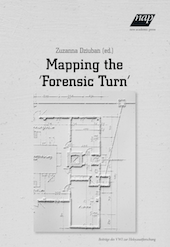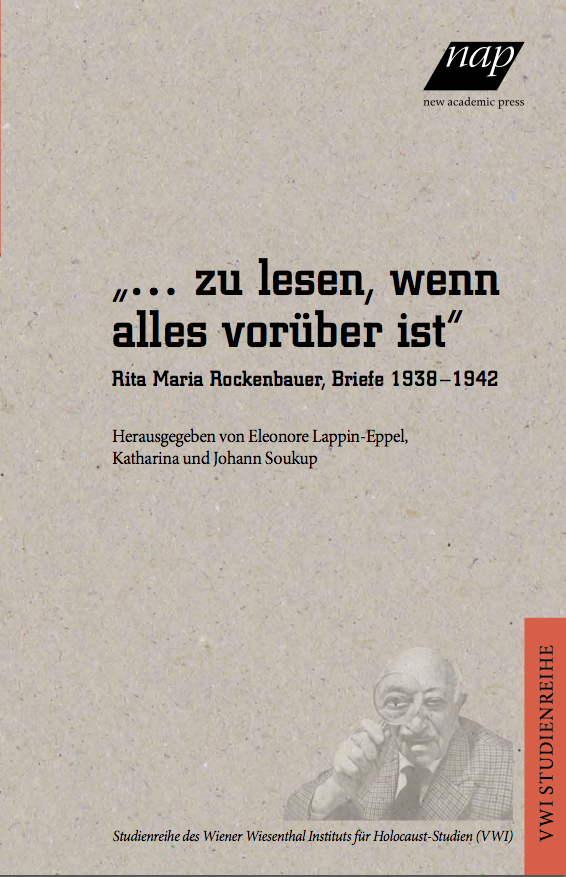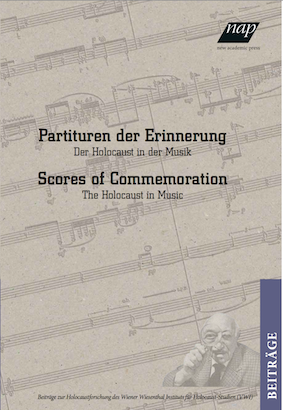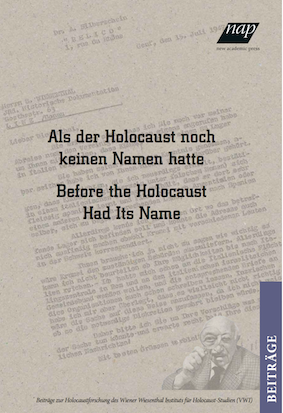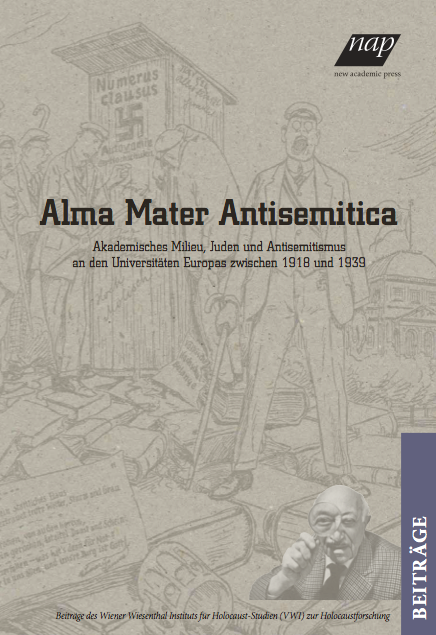 This article outlines the principal directions of my research: It focuses on the interplay of antisemitism and fascism in the ideology of the legionary movement in inter-war Romania as well as on the virtual consensus on antisemitism that was established in the 1930s as a result of the support for the movement received from most of the representatives of the ‘new generation’ of Romanian intellectuals. This consensus was pivotal in desensitising the general population towards the plight of Romanian Jews and making it possible for the discriminatory measures to gradually escalate into outright policies of extermination. Thus my research demonstrates the responsibility held by the legionary movement even though they were not directly involved in the Romanian wartime Holocaust perpetrated by the Antonescu regime: The legionary movement nevertheless promoted an antisemitic discourse that was much more extreme than that of all its predecessors and contemporaries, advocating a radical exclusion with genocidal overtones. Moreover, while being as ideological and abstract as its Nazi counterpart, legionary antisemitism posited religion rather than race as the basis for the exclusion of the Jews in line with the ideology of a movement that presented itself as ‘spiritual’ and ‘Christian’. The legionary exclusion based on religion proved as violent and murderous as the one based on race, both before and during the movement‘s time in power. As such, the evidence from the Romanian case study can serve to nuance and even challenge existing interpretations that identify only racist antisemitism as genocidal.
This article outlines the principal directions of my research: It focuses on the interplay of antisemitism and fascism in the ideology of the legionary movement in inter-war Romania as well as on the virtual consensus on antisemitism that was established in the 1930s as a result of the support for the movement received from most of the representatives of the ‘new generation’ of Romanian intellectuals. This consensus was pivotal in desensitising the general population towards the plight of Romanian Jews and making it possible for the discriminatory measures to gradually escalate into outright policies of extermination. Thus my research demonstrates the responsibility held by the legionary movement even though they were not directly involved in the Romanian wartime Holocaust perpetrated by the Antonescu regime: The legionary movement nevertheless promoted an antisemitic discourse that was much more extreme than that of all its predecessors and contemporaries, advocating a radical exclusion with genocidal overtones. Moreover, while being as ideological and abstract as its Nazi counterpart, legionary antisemitism posited religion rather than race as the basis for the exclusion of the Jews in line with the ideology of a movement that presented itself as ‘spiritual’ and ‘Christian’. The legionary exclusion based on religion proved as violent and murderous as the one based on race, both before and during the movement‘s time in power. As such, the evidence from the Romanian case study can serve to nuance and even challenge existing interpretations that identify only racist antisemitism as genocidal.
Editorial
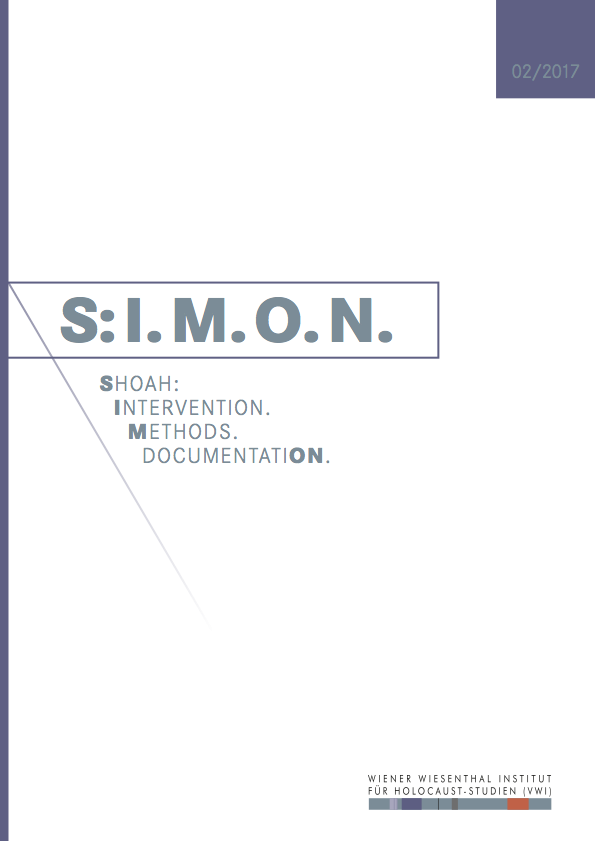 S:I.M.O.N. is an e-journal of the Vienna Wiesenthal Institute for Holocaust Studies (VWI). It appears twice a year in English and German language. S:I.M.O.N. aims at both a transnational and comparative history of the Holocaust and Jewish Studies in Central and Eastern Europe within the broader contexts of the European history of the 20th and 21st century, including its prehistory, consequences and legacies as well as the history of memory.
S:I.M.O.N. is an e-journal of the Vienna Wiesenthal Institute for Holocaust Studies (VWI). It appears twice a year in English and German language. S:I.M.O.N. aims at both a transnational and comparative history of the Holocaust and Jewish Studies in Central and Eastern Europe within the broader contexts of the European history of the 20th and 21st century, including its prehistory, consequences and legacies as well as the history of memory.
S:I.M.O.N. serves as a forum for discussion of various methodological approaches. The journal especially wishes to strengthen the exchange between researchers from different scientific communities and to integrate both the Jewish history and the history of the Holocaust into the different “national” narratives. It also lays a special emphasis on memory studies and the analysis of politics of memory. S:I.M.O.N. uses a double-blind review system, which means that both the reviewer’s and the author’s identities are concealed from each other hroughout the review process.
Shoah: The journal deals with the history of the Shoah from multidisciplinary, transnational and comparative perspectives. It seeks to integrate studies on Jews as well as on other groups of victims of the Holocaust, especially on Roma, and of so far less researched regions of (East) Central and (South) Eastern Europe.
Intervention. The journal reports on research projects and their transmission into public events. It also informs about current educational and remembrance programs.
Methods. The journal serves as a forum for the discussion of methodological approaches as, for instance, the everyday history, oral history, gender history, the history of violence, anti-Semitism and racism and the theory of memory and memory politics.
DocumentatiON. The journal contributes to critical approaches on using and interpreting archival materials in the 21st century.
Download the current issue S:I.M.O.N. 2017/2.
Articles
Katharina Friedla
„A Naye Yidishe Heym in Nidershlezye“. Polnische Shoah-Überlebende in Wrocław (1945-1949). Eine Fallstudie
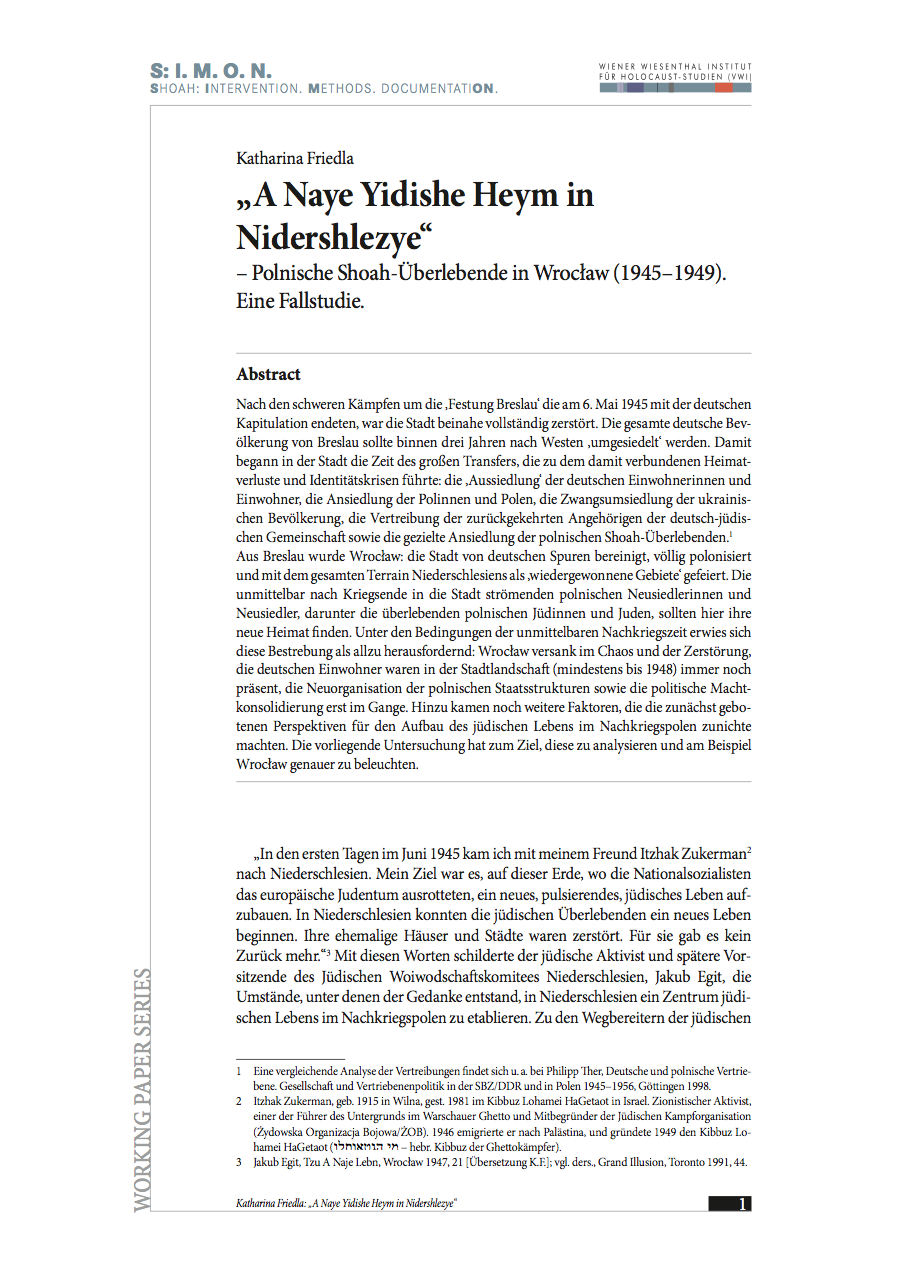 Heavy fighting around 'fortress Breslau' resulted in the German surrender on May 6, 1945 and almost completely destroyed the city. The following three years saw the 'relocation' of the city's entire German population to the West. It was the beginning of the city's great transfer period, which inevitably caused the losses of homes and identity crises: it included the ‚resettlement‘ of the German inhabitants, the settlement of Poles, the forced resettlement of the Ukrainian population, the expulsion of the returned members of the German-Jewish community as well as the directed settlement of Polish Shoah survivors. Breslau became Wrocław: the city was rid of German traces, utterly Polonized and, together with the entire area of Lower Silesia, celebrated as a „recovered territory“. The Polish settlers who surged into the city immediately after the end of the war, including Polish Jewish survivors, were supposed to find a new home there. This proved to be too great a challenge under the circumstances of the immediate post-war era: Wrocław was immersed in chaos and destruction, the presence of its German inhabitants was still apparent throughout the city (at least until 1948), the reorganization of the Polish state structures as well as the political consolidation of power was only just underway. Moreover, other factors also contributed to the demolition of initial prospects that Jewish life would be established in post-war Poland. This contribution aimed to analyse and illuminate these factors at hand of the example of Wrocław.
Heavy fighting around 'fortress Breslau' resulted in the German surrender on May 6, 1945 and almost completely destroyed the city. The following three years saw the 'relocation' of the city's entire German population to the West. It was the beginning of the city's great transfer period, which inevitably caused the losses of homes and identity crises: it included the ‚resettlement‘ of the German inhabitants, the settlement of Poles, the forced resettlement of the Ukrainian population, the expulsion of the returned members of the German-Jewish community as well as the directed settlement of Polish Shoah survivors. Breslau became Wrocław: the city was rid of German traces, utterly Polonized and, together with the entire area of Lower Silesia, celebrated as a „recovered territory“. The Polish settlers who surged into the city immediately after the end of the war, including Polish Jewish survivors, were supposed to find a new home there. This proved to be too great a challenge under the circumstances of the immediate post-war era: Wrocław was immersed in chaos and destruction, the presence of its German inhabitants was still apparent throughout the city (at least until 1948), the reorganization of the Polish state structures as well as the political consolidation of power was only just underway. Moreover, other factors also contributed to the demolition of initial prospects that Jewish life would be established in post-war Poland. This contribution aimed to analyse and illuminate these factors at hand of the example of Wrocław.
SWL-Reader
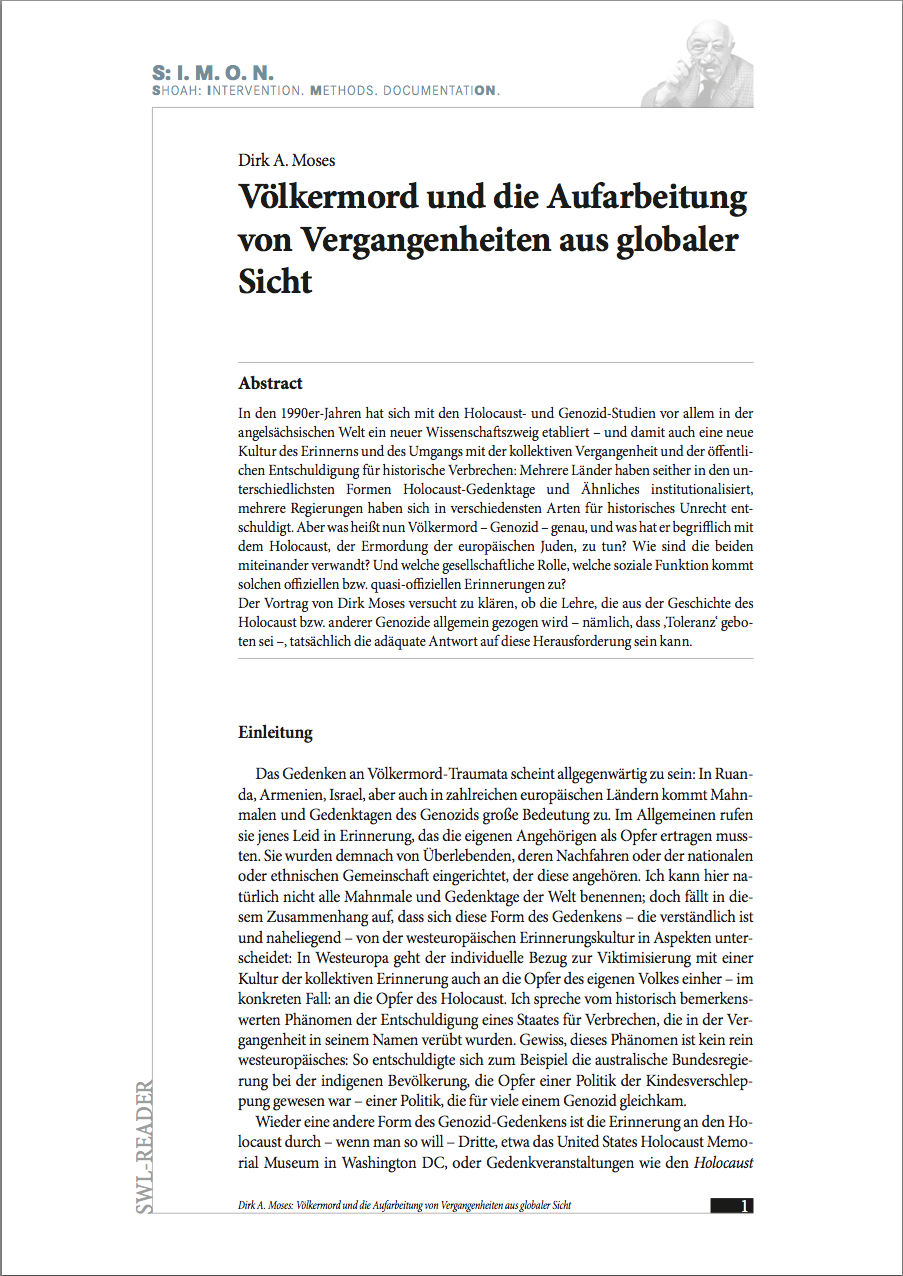 Holocaust and Genocide Studies emerged as a new discipline during the 1990s, particularly so in the Anglo-Saxon world. This development also established a new culture of remembrance and treatment of the collective past and public apologies for historical crimes. Since then, several countries have institutionalized Holocaust memorial days and similar institutions in a range of formats, several governments have apologized for historical injustices in various manners. Yet, there remains the question of a precise definition of a genocide – and in what way the term is connected to the Holocaust, the murder of the European Jews. How are these two related? What is the social function of such official or semi-official remembrances, and what is their role in society?
Holocaust and Genocide Studies emerged as a new discipline during the 1990s, particularly so in the Anglo-Saxon world. This development also established a new culture of remembrance and treatment of the collective past and public apologies for historical crimes. Since then, several countries have institutionalized Holocaust memorial days and similar institutions in a range of formats, several governments have apologized for historical injustices in various manners. Yet, there remains the question of a precise definition of a genocide – and in what way the term is connected to the Holocaust, the murder of the European Jews. How are these two related? What is the social function of such official or semi-official remembrances, and what is their role in society?
In his lecture, Dirk Moses endeavoured to clarify whether the insights gained from the history of the Holocaust and other genocides in general – namely, the imperative of 'tolerance' – really does provide an adequate answer to this challenge.
Events
Zoltán Halasi
Duschehubka
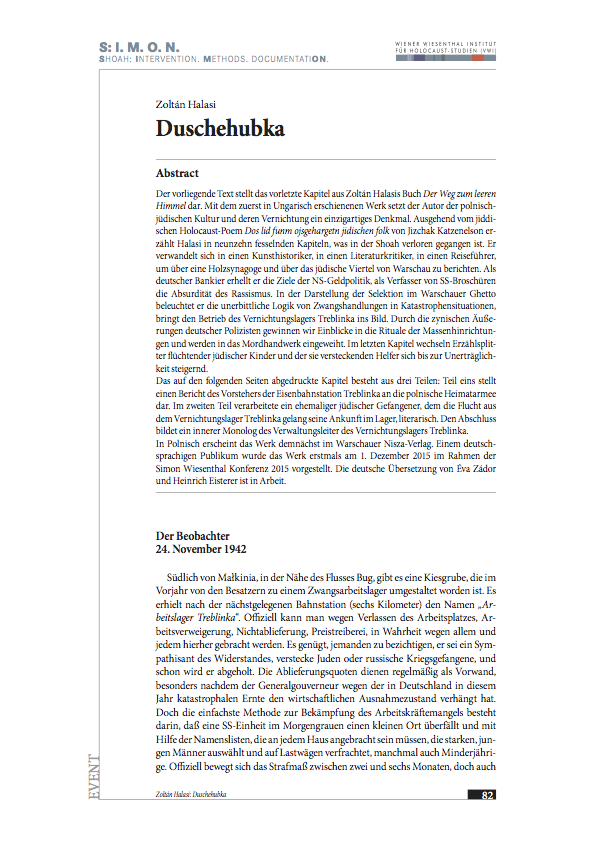 This text is the penultimate chapter of Zoltán Halasi's book Út az üres éghez (Road to an Empty Sky). With this work, which was first published in Hungarian, the author created a singular memorial to Polish-Jewish culture and its destruction. Setting out from the Yiddish Holocaust poem Dos lid funm ojsgehargetn jidischen folk by Itzhak Katzenelson, Halasi records what was lost in the Shoah in the course of nineteen compelling chapters. He takes on the grab of an art historian, a literary critic and a travel guide when he reports about a wooden synagogue and the Jewish quarter in Warsaw. In the role of a German banker, he illuminates the aims of the Nazi monetary policies, as a writer of SS brochures he highlights the absurdity of racism. Depicting a Selektion in the Warsaw ghetto, he shows the grim logic of compulsive acts in catastrophic situations, draws an image of the running of the extermination camp Treblinka. The cynical words of two German policemen provide an insight into the rituals of mass executions and introduce us to the craft of murder. The final chapter is an interplay of slithers of narrative by Jewish children on the run and by those who helped and hid them that borders on the unbearable.
This text is the penultimate chapter of Zoltán Halasi's book Út az üres éghez (Road to an Empty Sky). With this work, which was first published in Hungarian, the author created a singular memorial to Polish-Jewish culture and its destruction. Setting out from the Yiddish Holocaust poem Dos lid funm ojsgehargetn jidischen folk by Itzhak Katzenelson, Halasi records what was lost in the Shoah in the course of nineteen compelling chapters. He takes on the grab of an art historian, a literary critic and a travel guide when he reports about a wooden synagogue and the Jewish quarter in Warsaw. In the role of a German banker, he illuminates the aims of the Nazi monetary policies, as a writer of SS brochures he highlights the absurdity of racism. Depicting a Selektion in the Warsaw ghetto, he shows the grim logic of compulsive acts in catastrophic situations, draws an image of the running of the extermination camp Treblinka. The cynical words of two German policemen provide an insight into the rituals of mass executions and introduce us to the craft of murder. The final chapter is an interplay of slithers of narrative by Jewish children on the run and by those who helped and hid them that borders on the unbearable.
The chapter reproduced on the following pages has three parts: Part one is a Treblinka railway station master's report to the Polish Home Army. In the second part, a former Jewish detainee who managed to escape from the extermination camp Treblinka gives a literary treatment of his arrival at the camp. The final part consists of an inner monologue by the Treblinka extermination camp's director of administration.
The book will shortly be published in Polish at the Nisza publishing company in Warsaw. The German-speaking public was first presented with the work on December 1, 2015 at the Simon Wiesenthal Conference 2015. The German translation by Éva Zádor and Heinrich Eisterer is in progress.
Raul Cârstocea: The Path to the Holocaust. Fascism and Antisemitism in Interwar Romania
„... zu lesen, wenn alles vorüber ist“
Rita Maria Rockenbauer, Briefe 1938 –1942
Wien 2014
Partituren der Erinnerung.
Der Holocaust in der Musik
Scores of Commemoration.
The Holocaust in Music
Wien 2015
Before the Holocaust Had Its Name. Early Confrontations of the Nazi Mass Murder of the Jews
Wien 2016
Akademisches Milieu, Juden und Antisemitismus an den Universitäten Europas zwischen 1918 und 1939
Academic Milieu, Jews and Antisemitism at European Universities between 1918 and 1939
Wien 2016


